Diversity and Equity
Promoting STEM Interest and Identity Through the 4-H STEM Ambassadors Program
Connected Science Learning January-March 2019 (Volume 1, Issue 9)
By Janice McDonnell, Marissa Staffenova, Chad Ripberger, David Shernoff, Marycarmen Kunicki, Denise Bressler, and Christine Bean
The Rutgers University 4-H STEM Ambassadors program is a collaborative partnership between New Jersey public schools in urban communities in Paterson, Newark, Union, New Brunswick, Atlantic City, and Trenton and the Rutgers Cooperative Extension program. The program was designed to support America’s research and innovation capacity by increasing the participation of underrepresented minorities in science and engineering. In this article, we share some preliminary evidence that progress toward this goal is being achieved through the Ambassadors program.
Research indicates that the pipeline for maintaining the future U.S. STEM (science, technology, engineering, and math) workforce is uncertain (Maltese, Melki, and Wiebke 2014). For most of its history, the United States relied on a workforce that was predominantly male and overwhelmingly white and Asian. Recently, there have been gains for women in some fields but also an increasing reliance on international students in others (Lane 2015). Simultaneously, the demographics of the U.S. population are shifting. Groups that are the most underrepresented in STEM, including African Americans and Latinos, are also the fastest growing demographics in the U.S. general population (NAS 2011). By increasing the participation and success of underrepresented minorities in STEM, the 4-H STEM Ambassadors program strives to contribute to the health and security of the nation by expanding the STEM talent pool, enhancing innovation, and improving the nation’s global economic leadership.
Youth from low socioeconomic communities are at high risk for a number of poor education and employment outcomes, including academic failure, school dropout, suspension, expulsion, underemployment, and unemployment (Bradley and Corwyn 2002; Brooks-Gunn, Duncan, and Maritato 1997; Capella et al. 2008). Often, underserved youth perceive themselves as outside of the STEM professions (Rahm and Moore 2016). The purpose of the national Cooperative Extension System is to leverage the knowledge and resources of land-grant universities to address pressing problems in each state. One way that the Rutgers University Cooperative Extension program accomplishes this is by bringing science-based educational programs to local communities. This includes the 4-H Youth Development program, which provides opportunities, such as the STEM Ambassador program, for youth across the state to build confidence, skills, and citizenship.
The 4-H STEM Ambassadors Program aligns with the dimensions of A Framework for K–12 Science Education (NRC 2012) and the six strands of science learning suggested by Learning in Informal Environments: People, Places, and Pursuits (Bell 2009), which emphasizes participation in science instead of focusing only on developing content knowledge. Although Informal Strand 1 (excitement) and Informal Strand 6 (identify as a scientist) are important ideas in the formal science classroom, they tend to be secondary due to various constraints. However, these strands are an integral part of many informal science learning experiences, including the one provided via 4-H STEM Ambassadors.
Background
4-H is a public-private partnership led by 4-H National Headquarters at the National Institute for Food and Agriculture. National 4-H Council is the private sector, nonprofit partner of the 4-H program. Land grant universities administer 4-H programming in all 50 states. 4-H serves six million children ages 8–18 in 3,150 counties across the United States, including at-risk youth, and has a history of strengthening essential life skills. 4-H programs are strongly embedded in K–12 schools and communities throughout the nation. 4-H has three mission mandate themes, which are STEM learning, citizenship, and health living. The commitment from 4-H to improve STEM skills, which are critical to the nation’s future, is stronger now than ever before in the organization’s more than 100-year history of serving communities (Noyce Foundation 2013).
The 4-H STEM Ambassadors Program was established in 2009 with a Rutgers University seed grant to the Mercer County 4-H program. This grant was dedicated to providing opportunities for urban youth traditionally underserved in STEM to explore research occurring on the Rutgers campus, while gaining a better understanding of career opportunities available in STEM. Early on, the program’s focus was on wide-level exposure to hands-on activities and demonstrations in STEM disciplines, with youth spending five days on campus moving from activity to activity, learning about different STEM disciplines. However, it was not a fully connected experience because participants did not personally engage with scientists and engineers. In 2013 we completely changed the format of the on-campus residential program to become a guided journey that would help youth define their STEM pathway. Over the last decade, we have developed a model program based on Lyons, Jafri, and St. Louis’s (2012) Discover-Explore-Pursue Framework. Now, 4-H STEM Ambassadors learn and reflect on their own personal interests and abilities through three phases: Discover (orientation and personal connection to STEM mentors), Explore (hands-on experience using STEM skills), and Pursue (opportunity to conduct a mini research project and be mentored by a STEM professional).
Anatomy of the 4-H STEM Ambassador Program
Overview
In our program, rising ninth-grade youth from underserved communities experience an intensive, one-week residential program on the Rutgers University campus. During this formative week, they experience university life and learn about STEM careers while interacting with university scientists and engineers to solve real-world problems. Upon completion of their week, STEM Ambassadors fulfill a 50-hour service-learning requirement over the course of the school year by providing in-school, afterschool, and summer programming focused on STEM topics for younger children in their communities.
Student selection process
The program targets youth from groups underrepresented in STEM majors and careers, which includes girls and racial and ethnic minorities from urban communities throughout the state, in locations where 4-H collaborates with K–12, afterschool, and summer program providers. County 4-H offices partner with local school counselors, teachers, science curriculum supervisors, and program alumni to identify and recruit youth who will gain the most from the program. Recruitment is a multistep process that includes the submission of a written application and transcript, along with a short essay. Finally, 4-H county agents, program alumni, science curriculum supervisors, and guidance counselors interview students. Those selected receive scholarships to participate in the program and are registered as 4-H STEM Ambassadors. Each year, a new cohort of approximately 50–55 youth are welcomed into the program. To maintain continuity and peer leadership, we reserve 20% of the total slots (10 youth of the 50 in the cohort) for returning sophomore-, junior-, or senior-level students. The returning group is selected based on merit, and these students act as peer mentors and role models.
To date, 473 youth (61% female) from five New Jersey counties have participated in the program. Each year, the cohort averages about 40–45% African American and 40–45% Latino. The remainder is Caucasian and/or Asian and those who prefer not to identify with a single group.
Mentor participation
Rutgers scientists and engineers who contribute their time and expertise to the program are highly valued, essential partners and mentors to the STEM Ambassadors program. About 30 professors, postdocs, and graduate and undergraduate students participate as mentors over the course of the year. They invite Ambassadors into their labs and classrooms to participate in full-day research projects, and participate in roundtable discussions about their journeys in STEM. Mentors are trained by program staff on how to build mentorship and science communication skills. We discuss issues such as how to engage in meaningful science discussion, questioning and argumentation strategies, and how to keep youth safe to reduce liability and risk. About one-third of mentors report that they address the broader impacts of their research funded by the National Science Foundation through their involvement in the STEM Ambassador program.
Program outline
The program kicks off with a summer on-campus residential learning experience (Table 1) with three distinct phases: Discover, Explore, and Pursue.
Table 1. 4-H STEM Ambassador weeklong camp schedule
4-H STEM Ambassadors spend a week in Rutgers University dorms experiencing university life while meeting and working with scientists and engineers.
| Day | Activity |
|---|---|
| Monday | Campus STEM scavenger hunt, opening session |
| Tuesday | Discover STEM roundtable discussions and personal reflection, Explore STEM sessions, physics demonstrations, cookout, student panel and assistant dean Q&A, indoor recreation |
| Wednesday | Pursue STEM projects, STEM poster session preparations |
| Thursday | 4-H STEM Ambassador training: concurrent sessions, tours of campus farm |
| Friday | County sharing and reflection activities, STEM Poster Session, closing luncheon with speaker and recognition ceremony |
During the Discover phase, Ambassadors learn and reflect on their own personal interests and abilities. Ambassadors connect with STEM mentors through informal roundtable discussions and asking questions about career opportunities and required skills in STEM disciplines.
Also during this phase, Ambassadors engage in a series of exercises to reflect on their STEM pathways. They journal on a large index card and participate in peer discussions. Topics include:
- Interests: What you enjoy doing. When did you have a positive experience in science (or math, engineering, technology)? What was it like? Why did you like it?
- Skills: What you do well. Describe a talent or skill you have that you are really good at doing.
- Values: What motivates you. What skills do you want to work on over the course of the program?
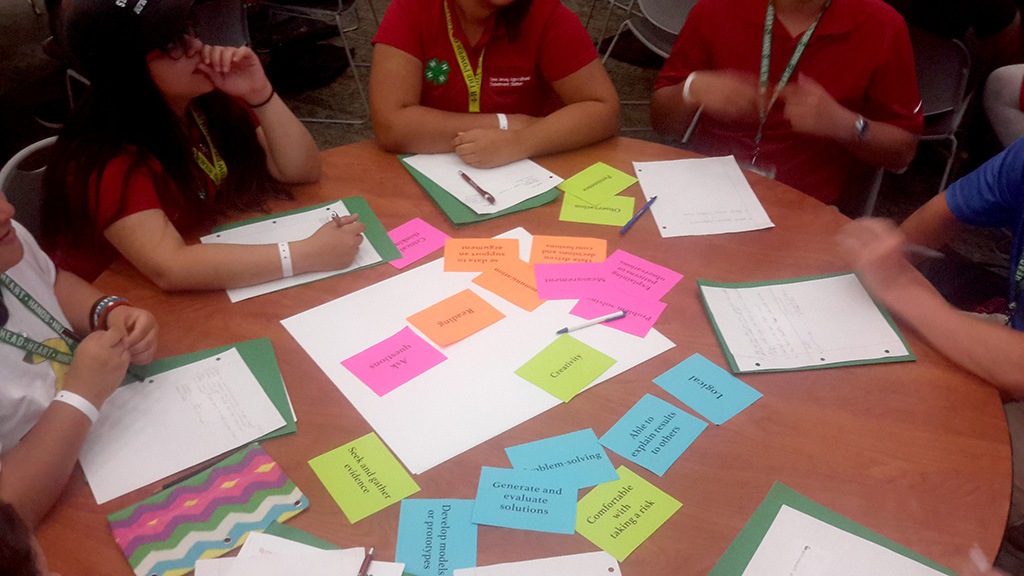
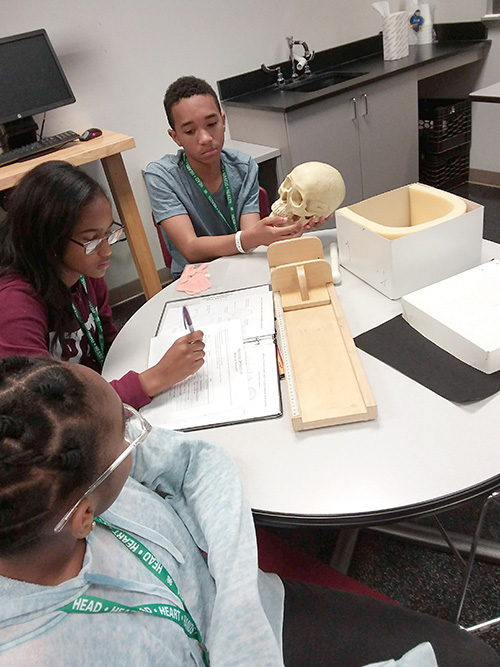
During the Explore phase, Ambassadors use STEM skills to engage in hands-on experiences. We partner with our on-campus Math and Science Learning Center to offer experiences typical of an undergraduate laboratory class. Ambassadors practice DNA extraction techniques, measure muscle strength, use math skills to predict an epidemiological disease outbreak, and use observation and critical-thinking skills to identify human bones in a crime scene. Ambassadors also experience university life in several ways. For example, they attend science demonstrations and take guided tours of university assets, including the gardens, farm, and other key laboratories and research sites.
During the Pursue phase, each Ambassador has the opportunity to participate in a mini research experience and be mentored by a STEM professional. Youth fill out a presurvey articulating their interest areas to guide placement in a research experience. Most of our Ambassadors get their first choice. Six or seven faculty members are selected to lead these intensive, one-day research experiences. Each faculty member works with 10 youth in small groups. Research topics from our most recent (2018) program include Python computer programming, robotics, forest ecology using geographic information systems (GIS) mapping, exercise physiology, and environmental science of microplastics. Each research experience starts with the collaborating professor giving an overview of his or her personal STEM pathway and current research interests. Ambassadors are then introduced to a scientific or engineering problem and engage in data collection and analysis. For example, Ambassadors participating in the forest ecology GIS mapping project use a data collector app on their phone to record the location and diameter of trees downed by Hurricane Sandy. Later, in the lab, they learn how to map their data. Then they use their newly created maps to answer questions about changes to the forest and the effects on various species.
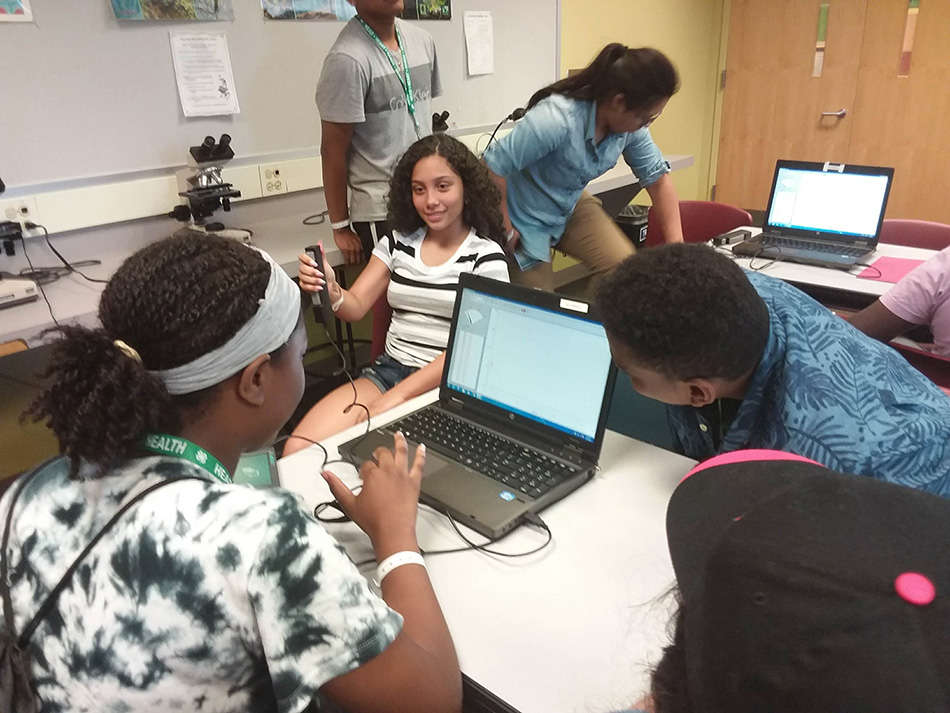
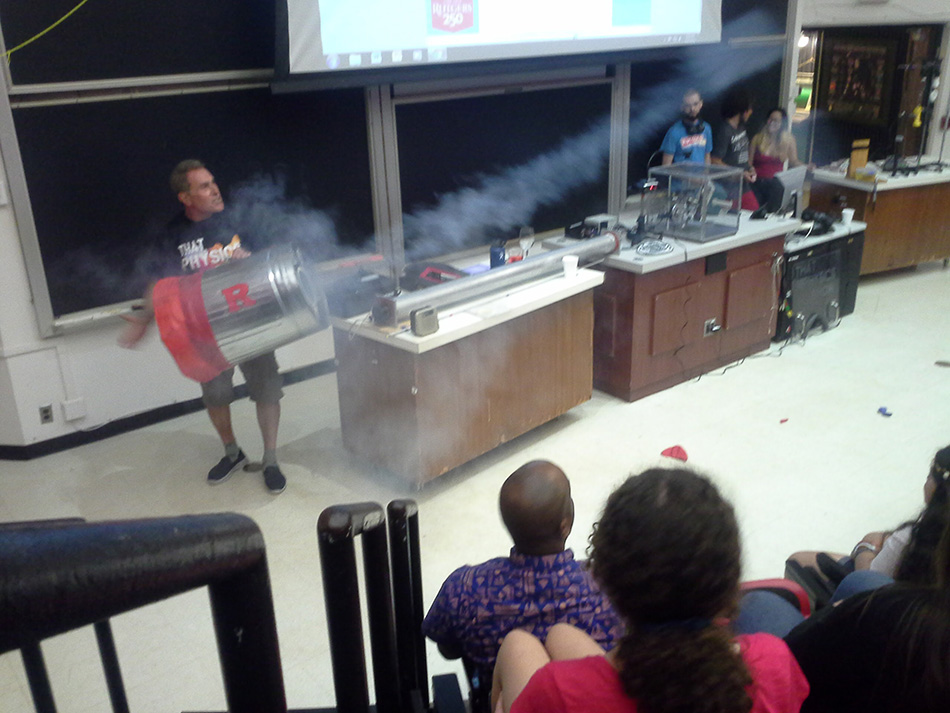
The day culminates in an evening discussion on the importance of science communication. Ambassadors are coached in effective science communication techniques and try their hand at creating a scientific poster. Posters are presented to the university community, family, and friends at a luncheon and recognition ceremony held on the final day of the summer program.
During the summer program, we dedicate one day to brainstorming and discussing how to teach science to K–8 youth. Ambassadors participate in curriculum training to learn a variety of hands-on STEM activities they can teach in their communities. They also learn about effective practices for teaching STEM and tips for mentoring younger students.
After the week on campus, Ambassadors are asked to stay involved with their local 4-H program and complete at least 50 hours of community service to engage peers and younger youth in STEM learning (Figure 1). This is an integral part of the program, allowing for continued engagement with 4-H science learning.
Long-term engagement
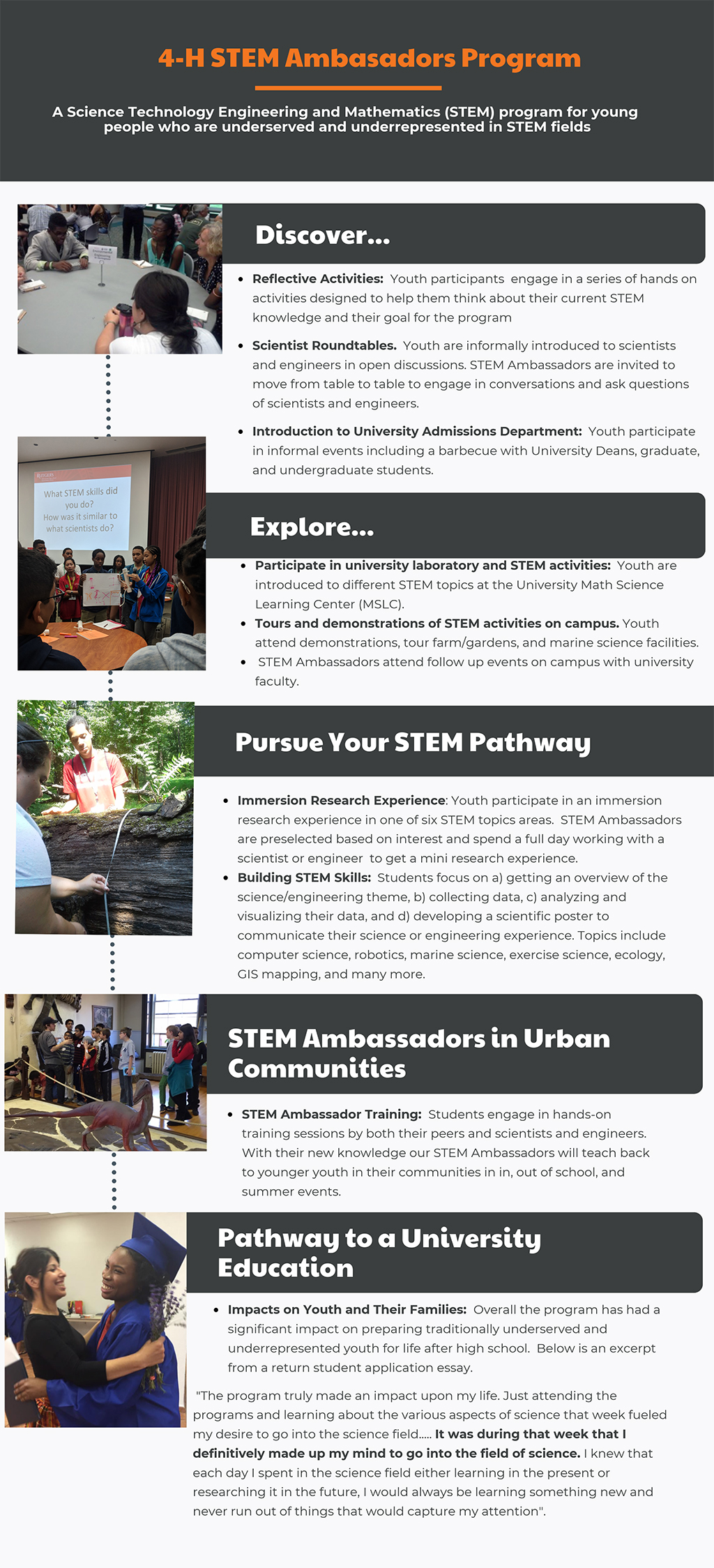
Annual survey results show that 96% of Ambassadors stayed involved with their local 4-H program by teaching hands-on science to youth and becoming 4-H club members. Ambassadors work with their county 4-H staff to plan and schedule a variety of community events. Teach-back opportunities include:
- working alongside 4-H staff and volunteers at out-of-school time programs and summer camps,
- hosting activity stations at community events and fairs, and
- leading workshops at day camps and local libraries.
Ambassadors also participate in other opportunities, including teen community service clubs, state conferences, and national 4-H events. For many, the STEM Ambassadors program is a gateway to a long-term relationship with 4-H. Some teens even find jobs working with 4-H.
Program outcomes
Annual pre- and postsurveys
Each year we conduct pre- and postsurveys to gauge participants’ weeklong summer experience. The survey uses items from Test of Science Related Attitudes (Fraser 1981), with questions designed to measure interest and engagement in STEM.
Results from 2018 show that Ambassadors reported significant increases in their interest in science, as well as their interest in having a STEM career (including as a scientist, engineer, or STEM educator) from the beginning to the end of the week. Based on the results of a Wilcoxon Signed Rank Test, the number of students out of 47 whose interest increased from the beginning to the end of the week was 14 in science, 13 in engineering, and 21 in STEM education. The number of students whose interest decreased was 3, 4, and 7, respectively. All test results were statistically significant. In addition, an increase in science interest was found to be associated with overall confidence in becoming a STEM professional. Importantly, nearly all Ambassadors indicated that they believed their opportunities to share their projects with scientists and peers resulted in increased confidence in themselves and their ability to do science.
One student wrote at the end of the week: “I can see how learning about my options in STEM, understanding the research process, and being more aware of my opportunities at Ambassadors will help me figure out my career pathway.” Another wrote, “This week was probably the best week of my life. I met so many new people and learned so many new things … I am very glad to say I might have found what I want to be.” These results are consistent with those from previous years indicating that interacting with scientists helped Ambassadors increase their understanding of scientific knowledge and visualize a career in STEM.
Longitudinal survey
A total of 243 youth participated in the STEM Ambassadors program from 2009 to 2014. In 2015 we phone-interviewed past program participants about their experience (n = 105, a 43% response rate). Analyses of the data show that:
- 50% reported positive change in motivation to learn about science.
- 82% believe interactions with scientists motivated and supported learning.
- 55% could see themselves as STEM professionals.
- 70% felt participation better prepared them for college.
- Ambassadors who said that the scientists supported their learning were more likely to see themselves as STEM professionals, a relationship that was statistically significant.
At the time of the phone survey, approximately 30% of respondents were enrolled in college and 65% were still in high school:
- Of those in high school: 72% were interested in pursuing a STEM major/career and 39% were interested in attending Rutgers University.
- Of those in college: 31% were attending Rutgers University and 59% were enrolled in a STEM major and were interested in pursuing a STEM career. Thirty-four percent were enrolled in premedical courses or interested in a medical career.
When past participants were asked to reflect specifically on the program components by which they were influenced, findings include:
- 25% said the program positively impacted their consideration of a STEM-related career.
- 29% referenced exposure to STEM practices as positively impacting their life.
- 20% cited social interactions as the primary factor that positively influenced them.
- 18% discussed the positive impact on their STEM interest and/or identity.
- Over 15% discussed how the program boosted their confidence.
- 13% discussed increases in science knowledge.
- Only 15% reported that the program did not significantly influence them.
A majority of Ambassadors (80%) responded that their experience with the program was positive and helped them shape their goals, widening their perspective in terms of possible STEM careers and areas of scientific study and research. Most importantly, most Ambassadors said that their interaction with scientists, interaction with fellow participants, and opportunities to share their projects resulted in increased confidence in themselves, improved interpersonal skills, and strengthened interest in science and engineering.
Ambassadors responded that they feel better prepared for college after participation because they were exposed to elements of college life; respondents referenced everything from living in the dorms, to waking up early for classes, to working in the labs and giving presentations. Participants also mentioned that the program had an important social component. They commented that they learned how to work together and interact with people they had not known before. Some participants also felt that the program helped them with organizational skills (e.g., time management) and helped them focus on a college major or particular career. Ambassadors also reported that it gave them hands-on experiences, confidence, and a sense of independence.
Ambassador essays
We also use alumni application essays to assess program impact. For example, when asked how interactions with scientists support STEM learning, one student responded:
I was granted the opportunity to see science in a whole new light. I stayed at Rutgers for five days, learning about different fields of science including microbiology, green engineering and biotechnology, anthropology, and my personal favorite, marine biology. In the marine biology lab, we were introduced to the robotic gliders and mapping system the marine biology team used to navigate and track the water systems all over the world. What intrigued me the most was how technology was being used in the process of navigating those systems. That moment was what led me to take an interest in engineering in general. The next year, I returned to the lab and was able to see the progress of the [marine biology lab’s] program, including a new 3-D control system simulator for the gliders, which could hopefully be used to navigate the gliders in the future. That new development in the program led me to narrow down my interest into computer engineering. I hope to take this inspiration and use it to develop technology that will help the community. One of the projects I hope to develop includes developing a program that helps autism truly speak: a program that acts as a communication system for children with autism. I hope to develop even more machines and software that will help the people of the world.
Challenges
One of the greatest program challenges is maintaining Ambassador engagement after the summer program. Competing personal and school demands on our Ambassadors’ time pose a significant barrier to maintaining high levels of involvement in the program over the course of the school year. Ambassadors often have home responsibilities, including sibling childcare. In many cases, their communities are not safe, making it challenging for them to walk to afterschool or evening meetings with scientist or engineer mentors. Parents have long work hours and often cannot assist their teens in getting to meetings and programs.
To help mitigate these challenges, 4-H county agents and their staff provide encouragement, a sense of belonging, and fun and enticing opportunities for the Ambassadors to remain engaged in the program. Agents also minimize logistical barriers by arranging for transportation to on-campus and community events.
In addition, funding and sustainability remains one of the biggest challenges to the program. Over the program’s 10 years, we have received grants from academia and industry (see promotional video from a partnership with Samsung). We continue to explore funding partnerships to sustain the STEM Ambassadors program.
Looking forward
We are highly committed to continuing our efforts to implement and improve a model program for underserved youth that supports a pathway to STEM disciplines.
We also continue to build strong partnerships with K–12 schools in urban areas to connect STEM learning both in and out of school. A middle school educator and program volunteer states:
The STEM Ambassador program has afforded my middle school students who are considered underrepresented in STEM careers the opportunity to participate by expanding their own thinking about STEM. In addition, these teenagers have been given time to listen [to] and learn from scientists currently in STEM areas while deepening their own reasoning about issues of concern, and then were able to share their ideas with others in the form of presentations, which has improved their ability to communicate to others. I personally have witnessed evidence of increased levels of confidence from 4-H club members [who] have attended the program and were my former students.
Our goal is to add a middle school program, hosting a similar but appropriately scaled version for younger audiences.
Key lessons learned
We have learned a great deal through our 10 years of the STEM Ambassador program. Our efforts have been documented in a publication by Derek Riley and Alisha Butler of Policy Studies Associates called Priming the Pipeline: Lessons from Promising 4-H Science Programs. The 4-H STEM Ambassador Program is one of eight 4-H science programs featured in this tier-2 evaluation effort of National 4-H Council with support from the Noyce Foundation. Below we list our key lessons learned in developing this STEM engagement program:
- Build and maintain strong relationships with K–12 schools to include youth who will benefit most from the program. Schools are the best sources for identifying youth who can benefit most from a program such as STEM Ambassadors. By partnering with curriculum supervisors and classroom educators, we have learned to select youth who are perhaps not the highest STEM achievers, but who show promise and interest in other ways.
- Provide training and nurturing to mentors to ensure positive youth development experiences. Our training program for scientist and engineer mentors is essential to creating consistent and coherent experiences for our youth.
- Engage with community partners for youth recruitment, funding, and program evaluation. By working with community leaders, nonprofit organizations, and county governments, we have been able to maintain support for the STEM Ambassador program. We continue to seek funding to expand our recruitment of youth and better evaluate our impacts.
- Most importantly, provide versatile learning opportunities for youth to create their own pathway through Discover, Explore, and Pursue opportunities. Through needs assessments that allow us to listen to our youths’ interests and ideas, we are able to anticipate and develop tailored programming that will excite and engage youth and adolescents in STEM.
Next steps
We strive to create a model that can be applied in other urban 4-H Extension programs. The STEM Ambassador program can be a critical tool for encouraging young people from groups traditionally underrepresented in STEM careers to pursue those professional pathways. We want to continue to explore the relational roles of schools, mentors, mentees, parents, peers, and valued others in building confidence and sustained interests, skills, and opportunities in STEM for youth. We strive to assess the quality of the STEM Ambassador learning environment to determine the strategies needed to promote students’ engagement with STEM. We are also interested in finding answers to the following questions: To what degree is engagement in STEM related to the development of STEM interests, identity, and career formation? How can we best promote sustained interest, identity, and career aspirations in STEM?
Acknowledgments
We gratefully acknowledge the support of our partner schools, university professors, postdocs, graduate students, undergraduate students, and 4-H faculty and staff. Without their volunteer efforts, we would not be able to make the STEM Ambassadors program a reality. Thanks to the wonderful youth participants and their families for being part of our Ambassador network.
Janice McDonnell (mcdonnel@marine.rutgers.edu) is STEM agent in the Department of Youth Development at Rutgers University in New Brunswick, New Jersey. Marissa Staffenova (mblodnik@njaes.rutgers.edu) is Essex County agent in the Department of Youth Development at Rutgers University in New Brunswick, New Jersey. Chad Ripberger (ripberger@njaes.rutgers.edu) is Mercer County agent in the Department of Youth Development at Rutgers University in New Brunswick, New Jersey. David Shernoff (david.shernoff@rutgers.edu) is associate professor of school psychology and director of the Rutgers Center for Mathematics, Science, and Computer Education at Rutgers University in New Brunswick, New Jersey. Marycarmen Kunicki (kunicki@njaes.rutgers.edu) is Passaic County agent in the Department of Youth Development at Rutgers University in New Brunswick, New Jersey. Denise Bressler (denise.bressler@rutgers.edu) is research associate at the Center for Mathematics, Science, and Computer Education at Rutgers University in New Brunswick, New Jersey. Christine Bean (bean@marine.rutgers.edu) is STEM program coordinator at Rutgers University in New Brunswick, New Jersey.


